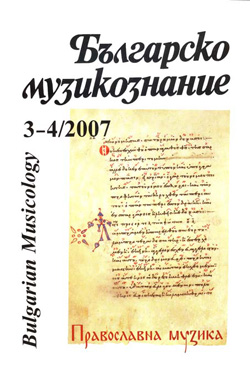Интонационните формули (ихими) като елемент от осмогласната система. Списъци с ихими във византийски пападики-трактати
The Intonation Formulae (Echemata) as an Element of the Eight-Mode System. Echemata-Lists in Byzantine Papadike Treatises
Author(s): Stanislava GeorgiavaSubject(s): Music
Published by: Институт за изследване на изкуствата, Българска академия на науките
Summary/Abstract: This study is focused on the echemata lists in the Byzantine papadike treatises. The intonation formulae known as echemata are examined in the context of the eight mode system (oktoechos). Observations on both the Byzantine modes and echemata are based on theoretical manuals. According to known evidence about the early use of intonational formulae, it is thought that they appeared as early as the eighth century, probably at the same time when the oktoechos itself took shape. From the earliest models of echemata list dating from the 12th-13th centuries to the later ones found in the late papadike treatises of 15th-I6th centuries, a developmental process can be ascertained. Together with the changes observed in the lists some elements remain stable and unchanged throughout the whole of this period. As a result of comparative study of the echemata lists, three levels of development are defined. They concern special characteristics that make each of the levels unique in comparison with the others. Akey position is assigned to a version of John Glykes’ didactic work comprising a full list of echemata of the modes. It is considered as a possible archetype for the echemata lists in the late Byzantine papadike. Some observations are made on the tetraphonos echema. It is examined from two points of view (according to its theoretical and practical use): first, as an universal one containing all the eight modes (their starting tones), plagal modes appearing through the descending tones and authentic modes through the ascending tones; and, second, as an individual one functioning as an intonational fonnula of a particular mode. Explanations of the meaning of echemata syllables as found in some music theories are presented. A theoretical text from Sinai music theory dealing with this matter written in question-answer form is given as an example. Various methods of indicating mode are discussed and illustrated with samples from early and late Byzantine manuscripts. The special kind of melismatic intonational formulae are not included in the present article; instead, they are the subject of a forthcoming publication. In conclusion, the development of echemata lists is characterized by a tendency toward their enrichment and extension. The changes are obviously a result of the general development in Byzantine church music: the rise and flowering of the kalophonic style, growing interest in modal theory, etc. Echemata reflect these changes in music theory and practice. After the Chrysanthos reform, music theory was based on new rules, which led to the rise of new shapes of echemata, which were quite different than the late Byzantine ones, characterized in the Mega Theoretikon of Chrysanthos as “interpreted according to the new method.”
Journal: Българско музикознание
- Issue Year: 2007
- Issue No: 3-4
- Page Range: 91-123
- Page Count: 33
- Language: Bulgarian
- Content File-PDF

